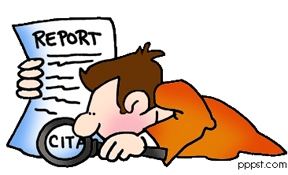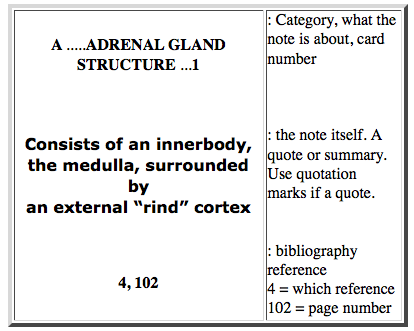
Research

........60NOTECARDS
You will be asked to take brief notes on 3 x 5 cards from some of the references you’ve found. Notecards may contain 1-2 sentences, quoted or paraphrased, or diagrams, definitions, etc. Notecards also contain a category title, and a code system to tell which reference and page the information was taken from. See below for a typical notecard. Only write notes which you feel will be usable in some way in writing a background research paper. DON’T WRITE notes if YOU do NOT understand what they mean!!!! Be sure to use your notecards by assigning a category title in the upper left hand corner, then, number them from 1-100+ in the upper right hand corner. (JUST IN CASE you drop them!!) A typed Bibliographic Reference Sheet must accompany the notecards, in which the numbered references match the coding system used on the notecards. Remember: you will need a minimum of 3 previous experiments that are similar to your project that provide information to validate your hypothesis. Be sure your research will be of value to you and your paper! EXAMPLE OF HOW A TYPICAL NOTECARD Web Sites For Research Assistance http://mrsgillumscience.com http://erinschumacher.com http://www.school.discovery.com/sciencefaircentral http://www.gsdsef.org http://www.usc.edu/CSSF/ http://www.gsdsef.org/GeneralInfo/links.shtml http://www.all-science-fair-projects.com/ http://pbskids.org/dragonflytv/scifair/index.html http://www.cool-science-projects.com/index.html http://www.cdli.ca/sciencefairs/intermed.html http://www.scifair.org/projects/ Science Buddies SF Guide http://www.sciencebuddies.org/mentoring/project_guide_index.shtml Lakewood Public Library Guide http://www.lkwdpl.org/study/sfair/ Another science teacher’s take on SF http://www.ri.net/schools/East_Greenwich/Cole/sciencefair.html
Search Engines for research paper: |
RESEARCH PAPER CLICK HERE FOR PDF OF PAPER OUTLINE CLICK HERE for Article by Judy Fisher: How to Get an A BIBLIOGRAPHIC SEARCH: THE FINAL WRITTEN RESEARCH PAPER Once a topic has been approved, the student may start researching their topic. A thorough understanding, thus serious research, is crucial to the success of the project. Often, through research, a student will develop their question even more and the project will get better and better. Before beginning the paper, students will spend over 2 weeks recording their research on note cards and creating a bibliography. There are 5 parts to the research paper, along with a few essential rules. RESEARCH PAPER PARTS: Brief summary Introduction (minimum 1/2, maximum
l page) Previous
Research in This Field Tie to Your Hypothesis Techniques
and Resources: 1-2 pages Core Science
Knowledge: 1-2 pages Conclusion: 1/2-1
page ESSENTIAL RULES
|
